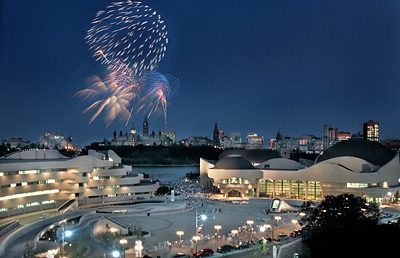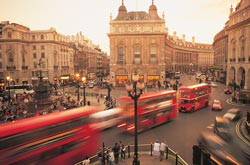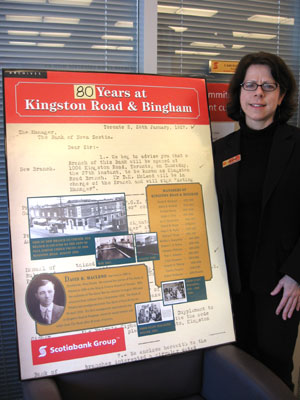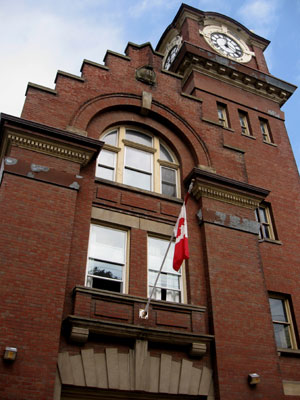5. What about the exhibitions that are currently running?
In addition to numerous permanent exhibitions throughout the Museum, the CMC presents over 15 special exhibitions each year. Currently the following exhibitions are presented at the CMC:
Lace Up: Canada’s Passion for Skating -A new exhibition at the Canadian Museum of Civilization tells the story of how skating has become one of the country’s most popular winter activities, intrinsic to life in Canada. Lace Up: Canada’s Passion for Skating is the first exhibition to explore the history of how the three ice sports of figure skating, hockey and speed skating developed in Canada. Now on at the Canadian Museum of Civilization until March 4, 2007.
Beads of Life: Eastern and Southern African Adornments – Extended until September 10, 2006. Since its opening on April 15, 2005, more than 100,000 visitors have seen this colourful exhibition that showcases for one of Africa’s most vibrant and enduring art forms and opens a window onto the contemporary forms and economic issues related to the artistry, history and meaning of African beaded adornments.
A Caring Profession: Centuries of Nursing in Canada -Throughout Canada’s history, the care and compassion of nurses have made the difference between life and death in our hospitals, homes and schools, as well as on battlefields and in the country’s remotest outposts. The compelling stories of Canada’s nurses are told in A Caring Profession: Centuries of Nursing in Canada, the most extensive exhibition to examine on the impact of nursing on the lives of Canadians, presented at the Canadian Museum of Civilization until July 30, 2006.
6. Please tell us about some of the Arts and Craft and Treasures exhibitions that have been held the Canadian Museum of Civilization.
The Museum has presented and co-produced a number of magnificent exhibitions including the following:
In 2002 we presented the exhibition The Mysterious Bog People: Rituals and Sacrifice in Ancient Europe. Since ancient times, bogs had a particular significance for people who lived in northwestern Europe. Shrouded in mists and often seeming dangerous and frightening, the bogs were used by local people to sacrifice their most valuable items in rituals that remain a mystery to this day.
This exhibition was a joint project of the Drents Museum (Assen, Netherlands), the Niedersächsisches Landesmuseum (Hanover, Germany), the Canadian Museum of Civilization and the Glenbow Museum (Calgary) and is the most comprehensive ever produced on the rituals of people living in North-western Europe in prehistoric times. It presented the latest research on the mysterious bog people who are little known to most of us
Arguably one of our most successful and much talked about exhibitions was Ancient Treasures and the Dead Sea Scrolls, presented in 2003 / 2004.This extraordinary exhibition was a once-in-a-lifetime opportunity for visitors to see a hundred extremely rare artifacts and manuscripts from the Biblical period, many of them never before seen outside Israel. Through these unique archaeological finds, discover over a thousand years of ancient history and the roots of two world religions, Judaism and Christianity.
In 1947, the first seven Dead Sea Scrolls were discovered in a desert cave by a young Bedouin shepherd searching for a lost goat. Over the next decade, archaeologists and Bedouins found portions of more than 900 scrolls in 11 nearby caves. Dated to the late Second Temple period (167 B.C.E. to 70 C.E.), the Dead Sea Scrolls are 1,000 years older Ancient Treasures and the Dead Sea Scrolls presented archaeological finds uncovered in Jerusalem, Massada, Qumram, and other cities of the biblical and Roman eras. They included three of the first Dead Sea Scrolls discovered, as well as the only known artifacts tied to the dynasty of King David. Also on display were personal and household items, such as jewelry, toys and cooking pots that spoke to the daily life in the ancient Holy Land.
In 2 months we will be presenting PETRA: Lost City of Stone – Founded in the first century B.C., Petra prospered for centuries at the confluence of the famous silk and spice roads, two of the greatest trade routes in world history in thwe desert of southern Jordan. The city drew its wealth from the camel caravans that ferried precious cargoes from India and Arabia to markets in Greece, Rome, Egypt and Syria. Its founders, the Nabataeans, are still hailed for their business acumen, artistic talents, and technical innovations. The fascinating city of Petra, with monumental stone-carved architecture and elaborate waterworks engineering is considered one of the most significant sites of antiquity. This exhibition will allow visitors a chance to rediscover a largely untold chapter of world history and behold more than 170 exceptional artifacts from museums in Jordan, Europe and the United States.
7. You also have held exhibitions on archeology, history and military history. Please tell us more about that.
The Canadian Museum of Civilization is primarily dedicated to the collection, preservation and telling of Canadian History and we have produced and presented some amazing exhibitions on our collective heritage.
From November 2003 to January 9, 2005 the CMC presented the exhibition Across Time and Tundra: The Inuvialuit of the Canadian Arctic. Inuit living in the western Canadian Arctic call themselves “Inuvialuit”, meaning “real human beings”, and have long considered themselves distinct from other Canadian Inuit. Today this distinct identity has a political dimension; the Inuvialuit chose not to join Nunavut (the new Inuit territory in the eastern Arctic), but to remain in the Northwest Territories under their own land claim agreement. The exhibition “Inuvialuit” explores the history of this unique Arctic people, from their first arrival in the Canadian Arctic from Alaska about a thousand years ago to the modern era. The exhibition highlights material collected by fur trader Roderick MacFarlane in the 1860s, and the photographic resources of the Anglican Archives, dating from the 1890s and was curated by Dr. David Morrison, Director of History and Archaeology at the Museum based on 20 years of research .
In June of 2004, the CMC opened a major new exhibition, Once in French America produced in celebration of the 400th anniversary of French settlement in North America. The guiding principle behind the exhibition was an examination of how new societies developed in North America. During the seventeenth and eighteenth centuries, immigrants to New France arrived with certain traditions, behaviors and institutions. However, in order to survive and prosper in a challenging new environment they also had to adapt everything they knew — often borrowing heavily from the traditions and technologies of First Peoples, as well as developing new methodologies of their own. The early settlers of New France were thus able to create and sustain societies with a vitality and influence that continues to this day. The exhibition featured approximately 500 artifacts and objects, representing all facets of life in New France drawn from some 40 institutions in Canada, the United States and France, bringing together one of the most extensive collections of New France artifacts for the very first time.
This past year we were also proud to present Acres of Dreams – Settling in the Canadian Prairies. This exhibition introduced visitors to the history of changing idealistic impressions of the West and explored the story of how and why the West has been perceived as a Canadian Utopia for the last 150 years. Visitors discovered a crucial chapter in Canada’s history, focusing on the challenges and experiences of millions of settlers, and the extraordinary international marketing campaign launched by the government to lure them to the West.
By launching the exhibit in 2005, the anniversary of the creation of the provinces of Saskatchewan and Alberta, the Museum took a national leadership role in celebrating this seminal date while presenting a major Western Canadian story that has never before been exhibited in either the East or West. This exhibition speaks to all Canadians of the great beauty of the Western land, and of the riches of its natural resources and showed that Prairie optimism endures, as new energy sources are found, and as pluralistic societies find a place for themselves in communities across the West.The exhibition was developed by the Canadian Museum of Civilization in collaboration with Library and Archives Canada.
8. The Canadian Museum of Civilization also houses an Imax Theatre, the Canadian Children’s Museum and the Canadian Postal Museum. Please tell us more about that.
The Canadian Children’s Museum has been one of the Canadian Museum of Civilization’s most popular attractions since it opened in 1989. Now almost three times its original size, the Canadian Children’s Museum (CCM) takes visitors of all ages on a Great Adventure. CCM passports in hand, visitors discover one incredible destination after another — from a mini-excursion to homes in the International Village, to a side trip to the World Exchange, the Kids’ Café, Building Works or Clothing Company. Whether on a trek to a desert pyramid, a jaunt to the Port of Entry to help unload a cargo ship, or a stroll through the bustling Market Bazaar, visitors encounter endless ways to learn about the world and each other.
The Canadian Postal Museum (CPM), founded in 1974, tells the story of postal communications in Canada and around the world. In 1988, the CPM joined the Canadian Museum of Civilization (CMC), and in June 1997, it officially opened its permanent premises inside the CMC. The programming of the Canadian Postal Museum has evolved over the years in response to its public. Since the Museum opened, visitors have been able to see multimedia presentations, art exhibitions, technological exhibitions, exhibitions of objects in the collection and thematic exhibitions illustrating how Canadians have communicated in writing with one another and with the rest of the world.
Visitors to the CPM can explore a number of interactive exhibitions including Stamp Quest™, an amusing introduction to the world of postage stamps and stamp collecting. The Reflections of Canada exhibition presents for the first time under the same roof a copy of every postage stamp ever issued in Canada and its provinces, a total of nearly 2,500 stamps. In this exhibition, visitors can use computer stations to consult the Canadian Postal Archives site or view the popular Heritage Minutes. A school programme complements the exhibition.
The Canadian Museum of Civilization’s IMAX® Theatre is the first of its kind in the world to combine two IMAX technologies. The giant IMAX screen is ten times the size of conventional movie screens and shows an image of stunning clarity. The IMAX DOME screen is a massive dome which tilts into place over the audience, providing a panoramic view that is as good as being there!
The theatre has 295 seats that tilt back to give audience members a full yet comfortable view. The vertical IMAX screen covers the entire front wall of the theatre and is 26 metres (87 ft.) wide and 19 metres (62 ft.) high. A second huge screen, the IMAX DOME, slides out of sight when not in use. It is 23 metres (76 ft.) in diameter and moves on an ingenious hoist system. The dome apparatus weighs 8,600 kg (18,960 lbs.). All the technology related to IMAX cameras and projectors was developed in Canada.
9. The Canadian Museum of Civilization also has a theatre company. Please tell us more.
As one of North America’s first resident museum theatre companies, Dramamuse has been delighting and enlightening visitors at the Canadian Museum of Civilization since its first performance on June 29, 1989. The company’s chief mandate is to interpret the collections of the Canadian Museum of Civilization, which it achieves by focusing primarily on short plays and visitor interaction during Museum hours. Dramamuse currently has over 50 short plays in its repertoire — varying in length from 8 to 25 minutes — all performed against the impressive backdrop of the Museum’s many exhibition halls. With its life-size reconstructions of historical settings, the Canada Hall is a particularly appropriate theatre venue, and it is there that numerous Dramamuse characters cross paths, and mingle with, Museum visitors.
10. What are some of the big news and special events coming up for the Canadian Museum of Civilization?
It’s hard to believe, but the Museum is really celebrating its 150th anniversary! The origins of the Museum date back to 1856, with the creation of the National Museum of Canada by the Geological Survey of Canada. Later, it became the National Museum of Man. In 1986, it was named the Canadian Museum of Civilization, and three years later, it moved to its present-day site in Gatineau. In honour of its 150th anniversary, the Museum of Civilization is opening a new long-term exhibition profiling the organization’s history from its origins to the present day, The Canadian Museum of Civilization: 150 Years of Cultural Exploration. A lively new book on the history of the institution from its origins to the present day, A World Inside: A 150-Year History of the Canadian Museum of Civilization will also celebrate the often dramatic history of Canada’s most popular museum.
The Museum will be holding an open house on May 14 and organizing a variety of activities. There will be a barbecue and a birthday cake, along with guided tours of the exhibitions and behind the scenes, films, entertainment for all ages, meetings with curators and more. Admission will be free, and most activities will be free as well.
Thank you, Yasmine, for this great overview. I hope I’ll be able to visit the Canadian Museum of Civilization on one of my next trips to Ottawa.









